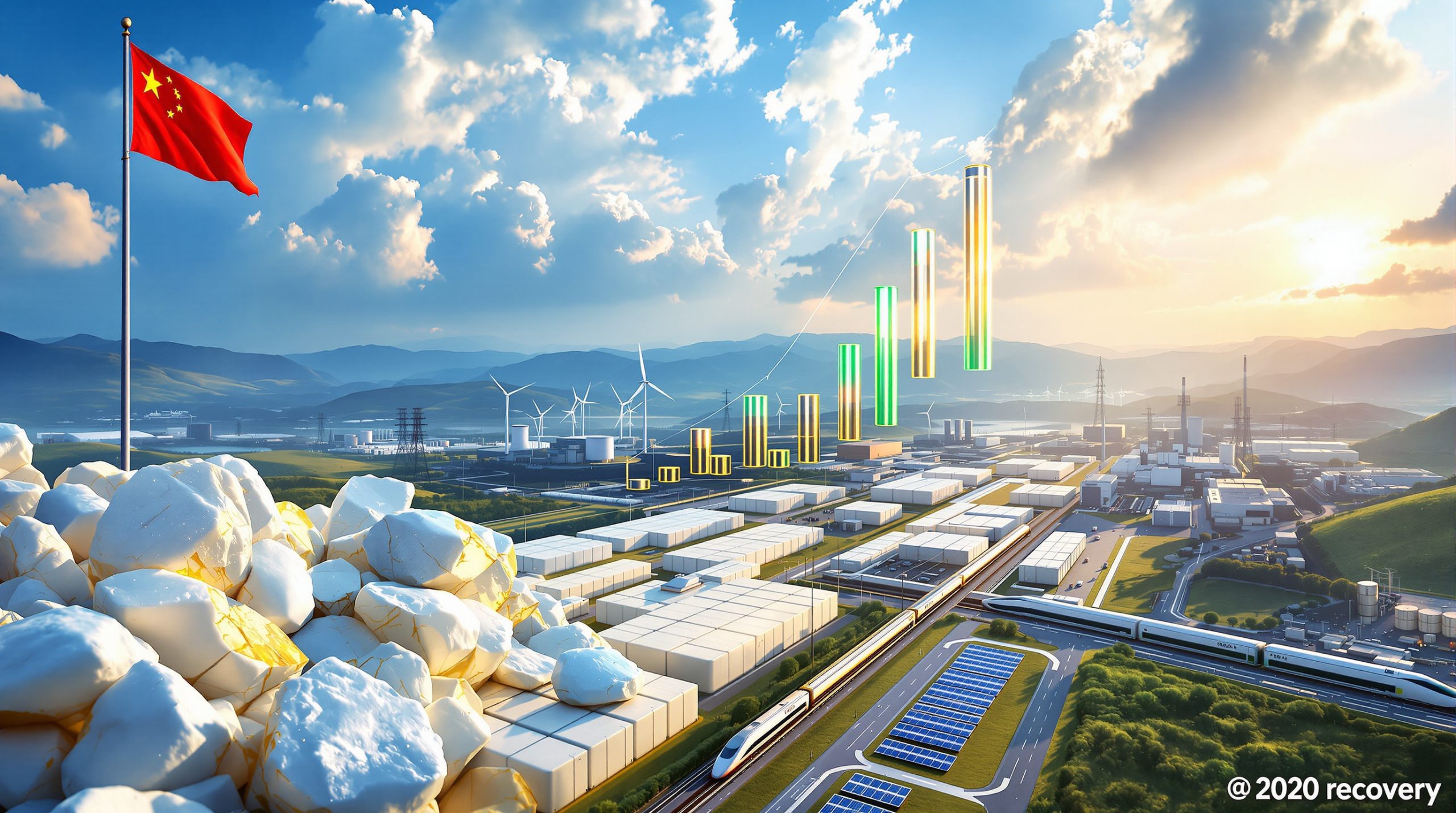What is Spodumene and Why is it Important for Lithium Extraction?
Spodumene is a pyroxene mineral consisting of lithium aluminium inosilicate (LiAl(SiO3)2) that serves as one of the most commercially important sources of lithium globally. This crystalline mineral typically contains 6-8% lithium oxide (Li2O) when processed as spodumene concentrate (SC6), making it a high-grade lithium ore for battery production.
The mineral's significance has grown exponentially with the surge in demand for lithium-ion batteries, particularly as electric vehicle adoption accelerates worldwide. Industry experts note that spodumene's relatively high lithium concentration makes it an increasingly strategic resource in the global energy transition.
According to recent geological assessments, high-quality spodumene deposits with grades above 1.5% Li2O are considered exceptionally valuable, with some premium Australian deposits reaching 2.4% Li2O content. Furthermore, innovative lithium production techniques from pegmatite sources are helping to maximize extraction efficiency.
How is Lithium Extracted from Spodumene?
The extraction of lithium from spodumene involves several complex processes due to the tight binding of lithium in the crystal structure. The primary methods include:
-
Traditional Acid Leaching Process:
- Dissolution of spodumene in acid
- Precipitation of impurities
- Concentration of lithium solution
- Conversion to lithium carbonate or hydroxide
- Results in significant caustic waste effluent and tailings
-
Pyrometallurgical Processing:
- Roasting at temperatures exceeding 800°C (1,470°F)
- Converting alpha-spodumene to more reactive beta-spodumene
- Cooling and reacting with various reagents
- Followed by hydrometallurgical processing steps
-
Tesla's Innovative Method (operational by 2025):
- Mixing sodium chloride with beta-spodumene concentrate and water
- Agitation at high temperatures to produce lithium-rich slurry
- Filtration and purification into lithium hydroxide
- Produces recyclable waste products (sands and limestone)
Industry insiders reveal that recovery rates from traditional processing methods typically range from 70-85%, though newer technologies aim to push this above 90%. The energy intensity of conversion is substantial, with estimates suggesting that converting alpha to beta spodumene requires approximately 2-3 GJ of energy per tonne of concentrate processed. Recent developments in advanced sorting technology are transforming lithium ore processing to improve efficiency.
Where is Spodumene Found Around the World?
Spodumene occurs naturally in lithium-rich granite pegmatites and aplites. Major global deposits and mining operations include:
-
Democratic Republic of Congo (DRC): Home to the world's largest lithium spodumene hard-rock deposit since 2018, with mining in Manono, Tanganyika Province. Geological surveys indicate grades averaging 1.65% Li2O across an estimated resource of over 400 million tonnes.
-
Australia: Leading global producer, with the Greenbushes mine in Western Australia containing ore at 2.4% Li2O. The Pilgangoora and Wodgina deposits have also emerged as world-class resources with substantial reserves. Australia's evolving lithium ambitions continue to shape the global market.
-
Other significant sources: Afghanistan (particularly the Nuristan Province), Brazil (Minas Gerais region), Madagascar (Ambatondrazaka area), Pakistan (Chitral District), Canada (James Bay and Abitibi regions in Québec), and the United States (Kings Mountain Belt in North Carolina and Pala District in California).
Geological evidence suggests that spodumene-bearing pegmatites typically form in orogenic belts associated with continental collision zones, with the most economically viable deposits often occurring in Archean and Proterozoic terranes. The United States has also developed the world's largest lithium reserve at Thacker Pass, though this is primarily clay-based rather than spodumene.
What Are the Economic Implications of Spodumene Mining?
Spodumene has significant economic importance in the global lithium market:
As of 2022, approximately 60% of all lithium is extracted from mineral ores, primarily spodumene, representing a shift from the historical dominance of brine-based production. World production via spodumene reached approximately 100,000 metric tonnes LCE (lithium carbonate equivalent) in 2021, with projections indicating potential growth to 300,000 tonnes by 2026.
Spodumene concentrate prices have demonstrated remarkable volatility, ranging from $400 per tonne during market lows to peaks exceeding $5,000 per tonne during supply shortages in recent years. This price volatility presents both significant opportunities and challenges for developers and investors. The lithium market in 2025 is expected to face both price drops and policy challenges that will further impact this volatility.
Australia solidified its position as the leading lithium-producing country through expanded spodumene mining, with its market share growing from 40% to 55% between 2018 and 2022. The high lithium concentration in spodumene offers distinct processing advantages over brine sources, despite requiring approximately 30-40% higher extraction costs.
Mining analysts note that the capital intensity for new spodumene operations typically ranges between $15,000-$20,000 per annual tonne of LCE capacity, with production costs generally falling between $5,000-$7,000 per tonne.
What Are the Physical and Chemical Properties of Spodumene?
Spodumene possesses several distinctive properties that affect its processing and applications:
-
Crystal Structure: Monoclinic system (α-spodumene) at low temperatures, converting to tetragonal (β-spodumene) above 900°C. This polymorphic transformation increases volume by approximately 30%, creating microfractures that enhance lithium extraction.
-
Composition: Lithium aluminium inosilicate, LiAl(SiO3)2, with theoretical lithium content of 8.03% Li2O when pure, though natural samples typically contain 6-7.5% Li2O due to impurities.
-
Hardness: 6.5-7 on the Mohs scale, making it resistant to mechanical weathering and challenging to process.
-
Color Variations: Highly variable – white, colorless, gray, pink, lilac, violet, yellow, and green, with colors resulting from trace element substitutions in the crystal lattice.
-
Associated Minerals: Quartz, albite, petalite, eucryptite, lepidolite, and beryl, with the mineral assemblage providing important clues to deposit genesis and potential processing challenges.
Metallurgists emphasize that spodumene's refractory nature in its alpha form necessitates the high-temperature conversion to beta-spodumene, as the alpha form is notably resistant to chemical attack by conventional reagents. Detailed information about these complex spodumene processing methods highlights the technical challenges involved.
What Are the Gemstone Varieties of Spodumene?
Spodumene has several valuable gemstone varieties prized for their unique properties:
-
Kunzite: Purple-colored variety containing trace amounts of manganese, discovered in 1902 and named after George Frederick Kunz. Premium specimens can command prices exceeding $1,000 per carat for exceptional clarity and color.
-
Hiddenite: Emerald-green variety colored by chromium, first reported from North Carolina and named after William Earl Hidden. Its rarity makes it among the most valuable colored gemstones, with high-quality specimens valued at $2,000-$3,000 per carat.
-
Triphane: Yellowish varieties of spodumene, less common in gem-quality material but still sought by collectors.
Gemologists note that spodumene gems exhibit distinct pleochroism (showing different colors when viewed from different angles) and are photosensitive, with kunzite particularly prone to color fading with prolonged exposure to sunlight.
How is Lithium from Spodumene Used in Modern Applications?
Lithium extracted from spodumene serves numerous industrial and consumer applications:
-
Battery Production: Primary use in lithium-ion batteries for electric vehicles and mobile devices, with high-purity lithium hydroxide from spodumene particularly valued for nickel-rich cathode formulations.
-
Ceramics and Glass: Used as a flux agent to lower melting temperatures and improve durability, with approximately 14% of global lithium consumption directed toward these applications.
-
Medicine: Component in psychiatric medications, particularly for bipolar disorder treatment, with specific pharmaceutical-grade lithium carbonate requirements.
-
Electronics: Essential in various electronic components, including heat-resistant glass for modern displays.
-
Specialty Materials: Used in Pyroceram and other advanced materials requiring thermal stability, with temperature expansion coefficients approaching zero in certain formulations.
Technical specialists highlight that spodumene-derived lithium hydroxide is increasingly preferred for high-nickel NMC and NCA battery cathodes due to its ability to withstand higher sintering temperatures during battery production, potentially extending EV range by 5-10% compared to carbonate-based alternatives. Recent scientific research on lithium extraction processes continues to improve efficiency and application potential.
What Are the Environmental Considerations in Spodumene Processing?
The environmental impact of spodumene processing varies by extraction method:
Traditional processing methods produce significant quantities of caustic waste effluent and tailings, with estimates suggesting that conventional conversion generates 8-12 tonnes of waste material per tonne of lithium carbonate equivalent produced. This includes sodium sulfate, calcium sulfate, and various aluminum silicate residues that require careful management.
Newer processing techniques aim to reduce waste streams through closed-loop refining processes. Some innovative approaches report up to 90% reduction in water consumption compared to conventional methods, with corresponding decreases in effluent generation.
Several companies are developing methods using non-caustic reagents to minimize environmental impact. Alternative leaching techniques using ammonium-based or organic compounds show promise in reducing both chemical consumption and hazardous waste production.
Waste products from newer methods can potentially be repurposed as construction materials. Preliminary studies indicate that aluminosilicate residues can substitute for up to 20% of cement in certain concrete applications, offering potential carbon footprint reductions.
Environmental experts emphasize that water consumption remains a critical consideration, with conventional processing requiring 50-100 cubic meters of water per tonne of lithium produced, though advanced recycling systems can reduce this by 60-70%.
How Does Spodumene Compare to Other Lithium Sources?
Spodumene has distinct advantages and disadvantages compared to alternative lithium sources:
-
Advantages over brine sources: Higher lithium concentration allows for more efficient extraction, with spodumene concentrate (SC6) containing approximately 2.8% elemental lithium compared to typical brines at 0.05-0.15%. Additionally, spodumene production can commence within 2-3 years of project approval, versus 4-7 years for brine operations.
-
Disadvantages: Higher extraction costs and more complex processing requirements, with energy consumption for roasting representing 25-35% of total production costs. Carbon footprint estimates suggest spodumene production generates 9-15 tonnes CO2e per tonne of lithium carbonate equivalent, versus 3-8 tonnes for brine operations.
-
Resource quality: Spodumene concentrate (SC6) with approximately 6% lithium content represents a high-quality lithium source, with mineralogical testing indicating that Australian and Canadian deposits frequently yield concentrates exceeding 6.2% Li2O with low iron content (<0.5%).
Industry analysts note that while spodumene operations have higher initial capital intensity than comparable brine projects, they typically achieve much faster ramp-up periods, with most hard-rock operations reaching nameplate capacity within 12-18 months compared to 3-5 years for brine operations.
What is the Future of Lithium Extraction from Spodumene?
The future of lithium extraction from spodumene is evolving rapidly:
Development of more environmentally friendly extraction processes is accelerating, with direct lithium extraction (DLE) technologies potentially reducing water consumption by up to 70% while increasing recovery rates to over 90%.
Expansion of mining operations in countries with significant deposits continues, with exploratory activities intensifying in emerging regions such as Zimbabwe, Mali, and Ghana, where geological surveys have identified promising pegmatite belts with spodumene mineralization.
Innovation in processing methods to reduce costs and environmental impact is advancing through techniques such as mechanical activation, which can potentially lower conversion temperatures by 100-150°C, representing significant energy savings.
Growing importance as demand for lithium-ion batteries continues to increase with electric vehicle adoption, with industry forecasts suggesting that spodumene-derived lithium could account for 65-70% of global supply by 2030, up from approximately 60% today.
Mining technology specialists predict that automation and digitalization of spodumene operations will improve concentrate grades by 0.3-0.5% Li2O while reducing processing costs by 15-20% through optimized crushing, optical sorting, and flotation circuits.
FAQ About Spodumene and Lithium Extraction
What percentage of lithium does spodumene contain?
Processed spodumene concentrate (SC6) contains approximately 6% lithium content, making it a high-grade lithium ore. This translates to roughly 2.8% elemental lithium, significantly higher than alternative sources like brines.
Which country has the largest spodumene deposits?
The Democratic Republic of Congo has been recognized since 2018 as having the world's largest lithium spodumene hard-rock deposit, with Australia being the leading producer. The Manono deposit in DRC is estimated to contain over 400 million tonnes of resource at 1.65% Li2O.
How is spodumene different from other lithium sources?
Spodumene offers higher lithium concentration than brine sources but requires more complex extraction processes and has higher associated costs. While brine operations typically have lower operating costs, spodumene projects generally have faster time-to-market and more consistent production rates unaffected by seasonal variations.
What are the main challenges in extracting lithium from spodumene?
The main challenges include the tight binding of lithium in the crystal structure, high energy requirements for processing, and managing environmental impacts of extraction. The alpha-to-beta conversion step alone typically consumes 2-3 GJ of energy per tonne of concentrate processed.
What is the difference between alpha and beta spodumene?
Alpha-spodumene is the naturally occurring low-temperature form in the monoclinic system, while beta-spodumene is the high-temperature form that crystallizes in the tetragonal system above 900°C and is more reactive for lithium extraction. The conversion process increases volume by approximately 30% and creates microfractures that enhance subsequent leaching efficiency.
Ready to Capitalise on the Next Major Lithium Discovery?
Discovery Alert's proprietary Discovery IQ model instantly notifies investors of significant ASX lithium discoveries, transforming complex mineralisation data into actionable investment insights ahead of the market. Explore how historic mineral discoveries have generated substantial returns by visiting Discovery Alert's dedicated discoveries page and begin your 30-day free trial today.




